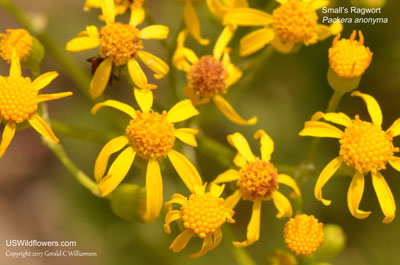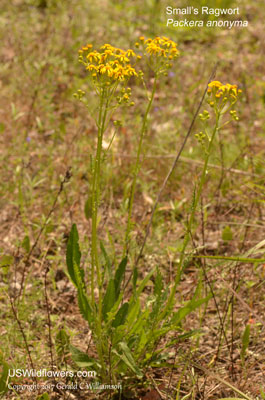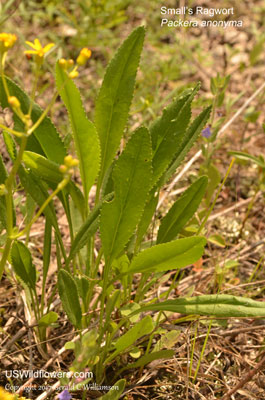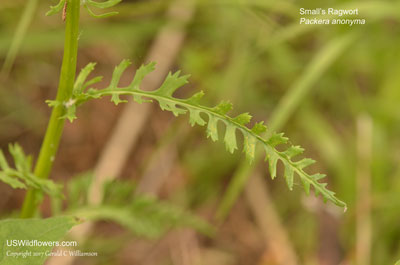Small's Ragwort, Appalachian Ragwort, Southern Ragwort, Plain Ragwort - Packera anonyma
|
Packera anonyma - Small's Ragwort, Appalachian Ragwort, Southern Ragwort, Plain Ragwort.
Packera was separated (along with Rugelia) from the Senecio genus. Packera contains what were categorized as the aureoid senecios (I assume this means "golden ragworts") by Asa Gray. The separation was partially based on genetic studies. There are around 65 species of Packera recognized worldwide, over 50 of which are found in the United States.
Packera anonyma - formerly Senecio anonymus, aka Senecio smallii - is found in a variety of drier habitats in much of the eastern United States, excluding mostly New England. The photos on this page were taken in a cedar glade in middle Tennessee. These glades are usually quite wet in the winter and early spring, but quite dry in late spring and summer. It is rare in the northeastern part of its range as well as in Indiana. It is described as being "almost weedy" in most other parts of its range.
Found in:
AL, DC, DE, FL, GA, IN, KY, LA, MD, MS, NC, NJ, NY, OH, PA, SC, TN, VA, WV
Leave comments on Packera anonyma at this link. | 
Distribution of Packera anonyma in the United States and Canada:

Blue=Native; Grey=Introduced
Map from USDA Plants Database:
USDA, NRCS. 2017. The PLANTS Database (http://plants.usda.gov, 08 May 2025). National Plant Data Team, Greensboro, NC 27401-4901 USA.
Search Our Database: Enter any portion of the Scientific, Common Name, or both.
Do a general Google search of the entire site:
#ad
 Follow USWildflowers on Twitter
#ad
| | Site: Couchville Cedar Glade, Davidson County, TN Date: 2017-May-11 | Photographer: Gerald C. Williamson
Nikon D7000
Tamron SP 90MM f/2.8 AF Macro | | The inflorescence of Packera anonyma is a corymb-like array - the lower/outer stalks are longer than those in the middle, so that all the flowers in the inflorescence are at more or less the same level, giving it a somewhat flat top. There may be several of these arrays on a plant, and the plant may have over 100 individual compound flowers. | | 
| | Site: Couchville Cedar Glade, Davidson County, TN Date: 2017-May-11 | Photographer: Gerald C Williamson
Nikon D7000 | | he blossom of Small's Ragwort is golden yellow, with both the ray and disk flowers being that color. The number of ray flowers is frequently an indicator of species in Asteraceae - I find some disagreement in various descriptions. The auspicious Flora of North America says "8 or 13" while the respected Wildflowers of Tennessee, the Ohio Valley, and the Southern Appalachians say "8 to 15." While I can count only 8 rays on those blossoms where the number is distinctly visible in my photos, I have seen other photos purported to be this species (insufficient diagnostics for me to say for sure) which had 9 rays. | | Click on the photo for a larger image

| | Site: Couchville Cedar Glade, Davidson County, TN Date: 2017-May-11 | Photographer: Gerald C Williamson
Nikon D7000 | | Packera anonyma grows up to around 3 feet tall, has both basal and cauline leaves, and may have from 20 to over 100 golden yellow blossoms. The stems are usually glabrous except near the bases and leaf axils. | | Click on the photo for a larger image

| | Site: Couchville Cedar Glade, Davidson County, TN Date: 2017-May-11 | Photographer: Gerald C Williamson
Nikon D7000 | | The basal leaves are narrowly elliptic, the blades being 2 to 8 times as long as wide - up to nearly a foot long, and have serrate margins. The base of the leaf tapers into and usually along the petiole. The surface is usually glabrous. | | Click on the photo for a larger image

| | Site: Couchville Cedar Glade, Davidson County, TN Date: 2017-May-11 | Photographer: Gerald C Williamson
Nikon D7000 | | The stem leaves are alternate and may be sessile or on petioles. They are reduced in size as the go up the stem. They are usually pinnately lobed. | | Click on the photo for a larger image

|
References used for identification and information:
|
|
| |
| #ad
|
|







